Family Limacodidae (Slug Moths)
The Limacodidae are a family of moths in the superfamily Zygaenoidea or the Cossoidea; the placement is in dispute. They are often called slug moths because their caterpillars bear a distinct resemblance to slugs.
They are small, hairy moths, with reduced or absent mouthparts and fringed wings. They often perch with their abdomens sticking out at 90° from their thoraces and wings.
The larvae are typically very flattened, and instead of prolegs, they have suckers. The thoracic legs are reduced, but always present, and they move by rolling waves rather than walking with individual prolegs. They even use a lubricant, a kind of liquified silk, to move. The larval head is concealed under folds.
Larvae might be confused with the similarly flattened larvae of lycaenid butterflies, but those caterpillars have prolegs, are always longer than they are wide, and are always densely covered in short or long setae (hair-like bristles). The head is extended during feeding in the lycaenids, but remains covered in the Limacodidae.
Many limacodid larvae are green and fairly smooth, but others have tubercles with urticating hairs and may have bright warning colours. The sting can be quite potent, causing severe pain.
Africa Wild Insect Book: Moths (Lepidoptera)
Moderator: Klipspringer
Africa Wild Insect Book: Moths (Lepidoptera)
Vivid Slug Latoia vivida
Superfamily Zygaenoidea. Family Limacodidae. Subfamily Limacodinae
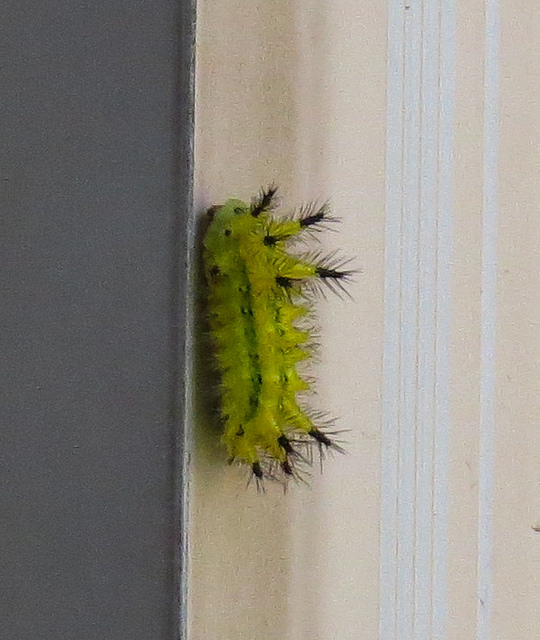 © steamtrainfan
© steamtrainfan
Pretoria
Description
27-31 mm. Hairy moth with green thorax. Fore wing mainly green. Outer edge with a narrow even brown margin.
Links:African Moths
Superfamily Zygaenoidea. Family Limacodidae. Subfamily Limacodinae
 © steamtrainfan
© steamtrainfanPretoria
Description
27-31 mm. Hairy moth with green thorax. Fore wing mainly green. Outer edge with a narrow even brown margin.
Links:African Moths
AW Insect Book Moths (Lepidoptera) Tortricidae
Family Tortricidae (Leaf Roller Moths)
Antennae roughly same length as body. Both wings broad, forewings square at tips. Dull brown or grey. Hindwings fringed with short hairs. Flies at dusk with rapid darting flight. Larva of some species feeds on fruit. Larva rolls up in leaf on which it feeds. Here it pupates to emerge as adult.
Antennae roughly same length as body. Both wings broad, forewings square at tips. Dull brown or grey. Hindwings fringed with short hairs. Flies at dusk with rapid darting flight. Larva of some species feeds on fruit. Larva rolls up in leaf on which it feeds. Here it pupates to emerge as adult.
AW Insect Book Moths (Lepidoptera) Tortricidae Olethreutinae
Olethreutine Leafroller Moth Eccopsis incultana
Family: Tortricidae. Subfamily: Olethreutinae. Tribe: Olethreutini. Subtribe: Neopotamiae
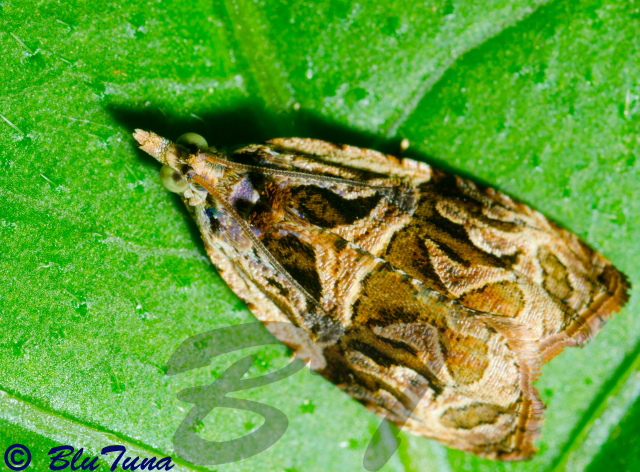 © BluTuna
© BluTuna
Garden in Johannesburg
Moths of the subfamily Olethreutinae are small with square tipped forewings and diverse wing patterns.
The caterpillars are leafrollers, they roll the leaves of their foodplant. Mature larvae pupate within leaf rolls.
Links: Butterfly and Moth of West Africa
Family: Tortricidae. Subfamily: Olethreutinae. Tribe: Olethreutini. Subtribe: Neopotamiae
 © BluTuna
© BluTunaGarden in Johannesburg
Moths of the subfamily Olethreutinae are small with square tipped forewings and diverse wing patterns.
The caterpillars are leafrollers, they roll the leaves of their foodplant. Mature larvae pupate within leaf rolls.
Links: Butterfly and Moth of West Africa
Hunting cannot be considered a sport as all contestants in a sport should know they are playing the game!
AW Insect Book: Moths (Lepidoptera) Psychidae
Family Psychidae (Bagworms)
Identification
Psychidae are small, mostly stout-bodied moths. Males very stout, dull-coloured, with transparent (often short and strong) wings without scales, comb-like antennae, and no mouthparts. Females are wingless, eyeless, legless, lack antennae, and remain in their larval cases.
Biology
Adults rarely encountered, but larvae are common. Lacking mouthparts, adult males are shortlived. They fly rapidly and erratically, searching for females. Most males fly by night and are attracted to lights. Mated females turn around in the case, lay eggs within and die.
Newly hatched larvae use vegetable debris, leaves or thorns to construct silk-lined portable cases that are often very diagnostic. The larvae construct cases out of silk and environmental materials such as sand, soil, lichen, or plant materials. These cases are attached to rocks, trees or fences while resting or during their pupa stage, but are otherwise mobile. The larvae of some species eat lichen, while others prefer green leaves. Bagworm cases range in size from less than 1 cm to 15 cm among some tropical species. Each species makes a case particular to its species, making the case more useful to identify the species than the creature itself.
Both males and females pupate within the case. A few species are parthenogenetic, males not being required for fertilization of eggs.
Habitat
Bushveld and wattle plantations.
About 134 species are known from the region. Subfamilies native to southern Africa:
Psychinae: 27 Genera and 71 species native to south Africa
Oiketicinae: 13 Genera and 19 species native to south Africa
Lypusinae: 1 Genus, Typhonia native to south Africa
Taleporiinae: 3 Genera and 9 species native to south Africa
Identification
Psychidae are small, mostly stout-bodied moths. Males very stout, dull-coloured, with transparent (often short and strong) wings without scales, comb-like antennae, and no mouthparts. Females are wingless, eyeless, legless, lack antennae, and remain in their larval cases.
Biology
Adults rarely encountered, but larvae are common. Lacking mouthparts, adult males are shortlived. They fly rapidly and erratically, searching for females. Most males fly by night and are attracted to lights. Mated females turn around in the case, lay eggs within and die.
Newly hatched larvae use vegetable debris, leaves or thorns to construct silk-lined portable cases that are often very diagnostic. The larvae construct cases out of silk and environmental materials such as sand, soil, lichen, or plant materials. These cases are attached to rocks, trees or fences while resting or during their pupa stage, but are otherwise mobile. The larvae of some species eat lichen, while others prefer green leaves. Bagworm cases range in size from less than 1 cm to 15 cm among some tropical species. Each species makes a case particular to its species, making the case more useful to identify the species than the creature itself.
Both males and females pupate within the case. A few species are parthenogenetic, males not being required for fertilization of eggs.
Habitat
Bushveld and wattle plantations.
About 134 species are known from the region. Subfamilies native to southern Africa:
Psychinae: 27 Genera and 71 species native to south Africa
Oiketicinae: 13 Genera and 19 species native to south Africa
Lypusinae: 1 Genus, Typhonia native to south Africa
Taleporiinae: 3 Genera and 9 species native to south Africa
AW Insect Book Moths (Lepidoptera) Psychidae Oiketicinae
Bagworm Moth possibly Acanthopsyche sp.
Superfamily Tineoidea. Family Psychidae. Subfamily Oiketicinae
 © mposthumus
© mposthumus
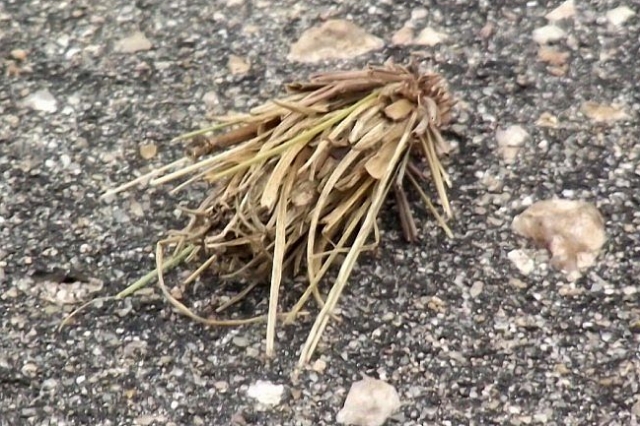 © mposthumus
© mposthumus
Kruger National Park
Links:
https://www.biodiversitylibrary.org/ite ... 1/mode/1up
https://www.biodiversitylibrary.org/ite ... 8/mode/1up
Superfamily Tineoidea. Family Psychidae. Subfamily Oiketicinae
 © mposthumus
© mposthumus © mposthumus
© mposthumusKruger National Park
Links:
https://www.biodiversitylibrary.org/ite ... 1/mode/1up
https://www.biodiversitylibrary.org/ite ... 8/mode/1up
Re: Insect or Invertebrates Identification
Unidentified Moth, family Erebidae
 © BluTuna
© BluTuna
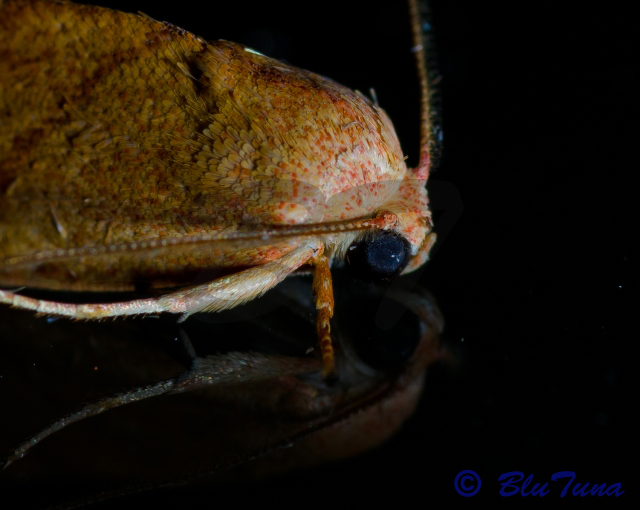 © BluTuna
© BluTuna
Kruger National Park
 © BluTuna
© BluTuna © BluTuna
© BluTunaKruger National Park
Hunting cannot be considered a sport as all contestants in a sport should know they are playing the game!
Re: Africa Wild Insect Book: Moths (Lepidoptera)
Striped Hawk Hyles livornica
Family: Sphingidae Subfamily: Macroglossinae
Eugen Johann Christoph Esper described the striped hawk-moth in 1780 using a specimen found in Italy at Livorno (hence the Latin name "livornica")
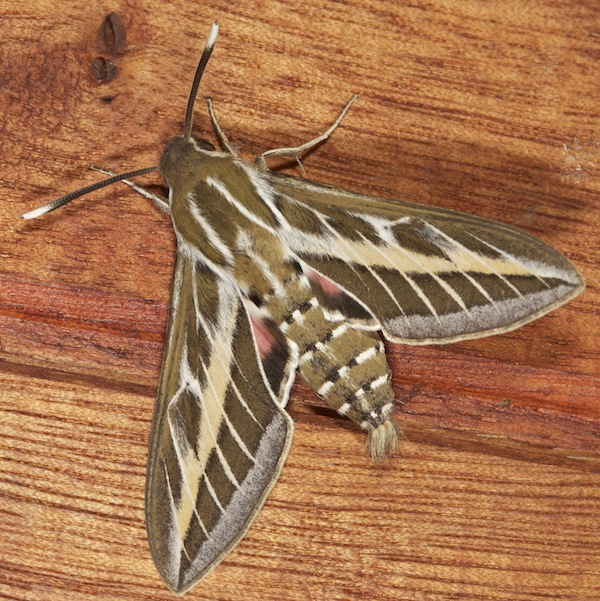
KTP
Description
Similar to many other species of the genus, but with distinctive, white forewing venation.
Hyles livornica has a wingspan reaching 60–80 mm. Males are slightly smaller than females. The fore wings and the body are mainly olive brown or beige, with white stripes. The hind wings are pink, with black and white edges. The head and the thorax are olive-brown, with white stripes. The olive-brown abdomen has black-and-white segments, the first two segments have large black and white side spots. The antennae are dark olive brown and have a white tip.
Although extremely variable in size, with some individuals dwarfing others, it exhibits very little other variation except in the intensity of coloration and degree of pattern. In the southern Sahara, small pale individuals occur which are referable to form: saharae
Distribution
Afro-Palaearctic distribution: This species is a migrant from Africa to Europe.
The Afrotropical Region, excluding the equatorial forest belt of the Congo in West Africa. Common in southern Europe and North Africa to Asia minor, thence to southern India and China.
Flight Period
An extremely active species, normally flying towards evening, when considerable numbers are often attracted to sweet-smelling flowers and to light. Pairing always takes place at dawn over a period of two or three hours. Thereafter, females can cover considerable distances whilst egg-laying. In southern Europe and North Africa, many are also active during daylight hours, especially when on migration.
Early Stages
OVUM: Slightly oval (1.1 x 1.0mm), glossy and pale green. Tiny for the size of moth. Laid on the upper and underside of leaves of the host plant, with four or five to a small plant.
LARVA: Full-fed, 65--80mm. Polymorphic. The caterpillars are green, with black markings.
At all stages, larvae feed quite openly on their low-growing host plants, alternating bouts of frenzied feeding, when large quantities of food are consumed, with spells of basking. When disturbed, young individuals will drop from the plant; older larvae will twitch violently from side to side while regurgitating green digesta.
PUPA: 30--45mm. More elongate than most Hyles species and variable in the amount of brown coloration present, some being yellowish or even translucent. Like others of the genus, encased in a flimsy, silk cocoon amongst ground litter or in a grass tussock. Overwinters as a pupa and may diapause for more than one year.
Larval Food Plants
Boerhavia elegans, Bulbine asphodeloides, Aloe striata, Acacia, Antirrhinum, Asparagus, Rhazya stricta, Eremurus, Fragaria, Fuchsia, Galium, Oldenlandia, Pelargonium, Plantago, Rumex, Valeriana, Vitis, Zygophyllum fabago, Prunus, Polygonum, Portulaca, Gossypium,, Vitis, Euphorbia, Linaria, Epilobium, , Scabiosa, Linum, Asphodelus.
Parasitoids
Tachinidae: Drino vicina, Drino (Palexorista) imberbis, Nemorilla maculosa, Spoggosia aegyptiaca.
Links:
http://tpittaway.tripod.com/sphinx/h_liv.htm
http://www.africanmoths.com/pages/SPHIN ... ornica.htm
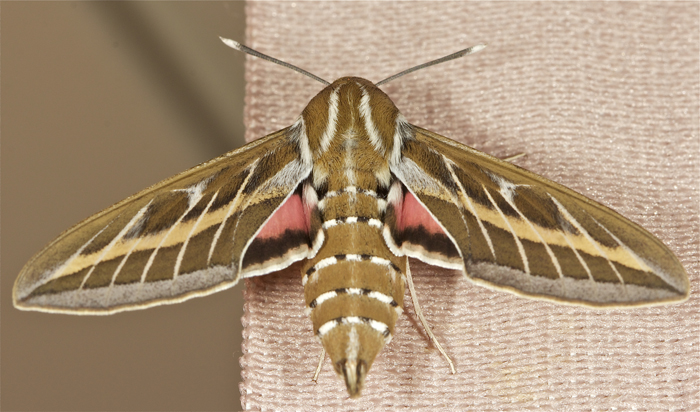
Kgalagadi Transfrontier Park
Family: Sphingidae Subfamily: Macroglossinae
Eugen Johann Christoph Esper described the striped hawk-moth in 1780 using a specimen found in Italy at Livorno (hence the Latin name "livornica")

KTP
Description
Similar to many other species of the genus, but with distinctive, white forewing venation.
Hyles livornica has a wingspan reaching 60–80 mm. Males are slightly smaller than females. The fore wings and the body are mainly olive brown or beige, with white stripes. The hind wings are pink, with black and white edges. The head and the thorax are olive-brown, with white stripes. The olive-brown abdomen has black-and-white segments, the first two segments have large black and white side spots. The antennae are dark olive brown and have a white tip.
Although extremely variable in size, with some individuals dwarfing others, it exhibits very little other variation except in the intensity of coloration and degree of pattern. In the southern Sahara, small pale individuals occur which are referable to form: saharae
Distribution
Afro-Palaearctic distribution: This species is a migrant from Africa to Europe.
The Afrotropical Region, excluding the equatorial forest belt of the Congo in West Africa. Common in southern Europe and North Africa to Asia minor, thence to southern India and China.
Flight Period
An extremely active species, normally flying towards evening, when considerable numbers are often attracted to sweet-smelling flowers and to light. Pairing always takes place at dawn over a period of two or three hours. Thereafter, females can cover considerable distances whilst egg-laying. In southern Europe and North Africa, many are also active during daylight hours, especially when on migration.
Early Stages
OVUM: Slightly oval (1.1 x 1.0mm), glossy and pale green. Tiny for the size of moth. Laid on the upper and underside of leaves of the host plant, with four or five to a small plant.
LARVA: Full-fed, 65--80mm. Polymorphic. The caterpillars are green, with black markings.
At all stages, larvae feed quite openly on their low-growing host plants, alternating bouts of frenzied feeding, when large quantities of food are consumed, with spells of basking. When disturbed, young individuals will drop from the plant; older larvae will twitch violently from side to side while regurgitating green digesta.
PUPA: 30--45mm. More elongate than most Hyles species and variable in the amount of brown coloration present, some being yellowish or even translucent. Like others of the genus, encased in a flimsy, silk cocoon amongst ground litter or in a grass tussock. Overwinters as a pupa and may diapause for more than one year.
Larval Food Plants
Boerhavia elegans, Bulbine asphodeloides, Aloe striata, Acacia, Antirrhinum, Asparagus, Rhazya stricta, Eremurus, Fragaria, Fuchsia, Galium, Oldenlandia, Pelargonium, Plantago, Rumex, Valeriana, Vitis, Zygophyllum fabago, Prunus, Polygonum, Portulaca, Gossypium,, Vitis, Euphorbia, Linaria, Epilobium, , Scabiosa, Linum, Asphodelus.
Parasitoids
Tachinidae: Drino vicina, Drino (Palexorista) imberbis, Nemorilla maculosa, Spoggosia aegyptiaca.
Links:
http://tpittaway.tripod.com/sphinx/h_liv.htm
http://www.africanmoths.com/pages/SPHIN ... ornica.htm

Kgalagadi Transfrontier Park
-
Klipspringer
- Global Moderator
- Posts: 5858
- Joined: Sat Sep 14, 2013 12:34 pm
- Country: Germany
- Contact:
Re: AW Insect Book: Moths (Lepidoptera) Geometridae Ennominae
Geometer Moth Chiasmia sp.
Family: Geometridae. Subfamily: Ennominae. Tribe Macariini
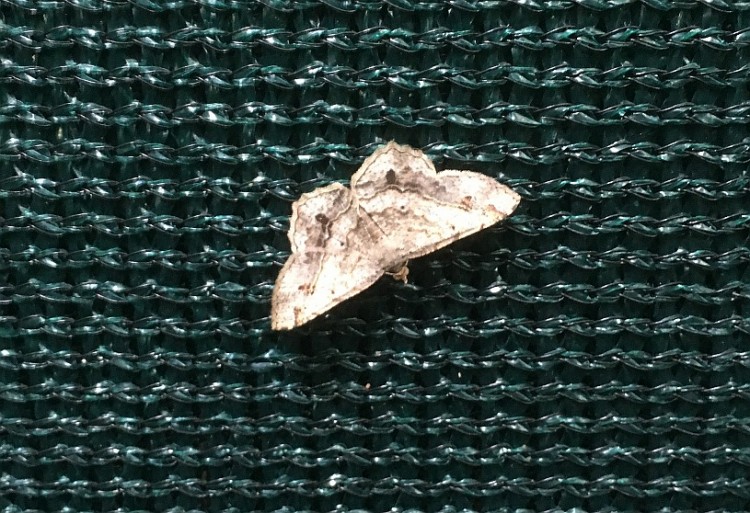
Thonga Beach, KZN, South Africa © GlosterBirder
Family: Geometridae. Subfamily: Ennominae. Tribe Macariini
Thonga Beach, KZN, South Africa © GlosterBirder
-
Klipspringer
- Global Moderator
- Posts: 5858
- Joined: Sat Sep 14, 2013 12:34 pm
- Country: Germany
- Contact:
Re: Africa Wild Insect Book: Moths (Lepidoptera)
Duke's Eggarlet Bombycomorpha dukei
Family: Lasiocampidae. Subfamily: Lasiocampinae

 © nan
© nan
Namaqualand
Distribution
Namaqualand endemic.
Biology
Larval foodplants: Searsia undulata.
Links:
African Moths
https://www.zobodat.at/pdf/Neue-Entomol ... 3-0117.pdf
Family: Lasiocampidae. Subfamily: Lasiocampinae

 © nan
© nanNamaqualand
Distribution
Namaqualand endemic.
Biology
Larval foodplants: Searsia undulata.
Links:
African Moths
https://www.zobodat.at/pdf/Neue-Entomol ... 3-0117.pdf


